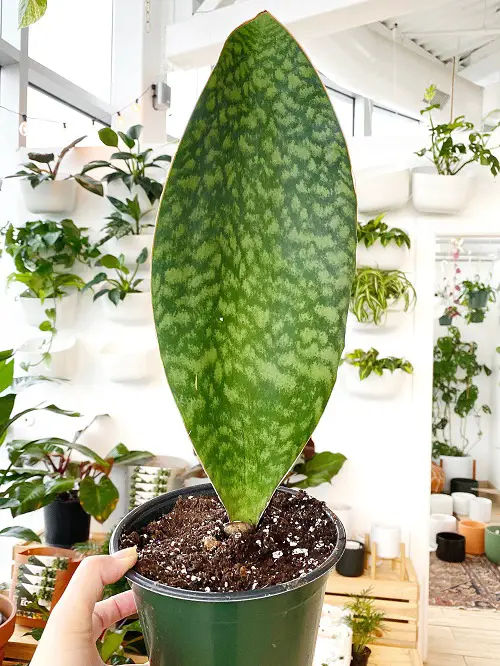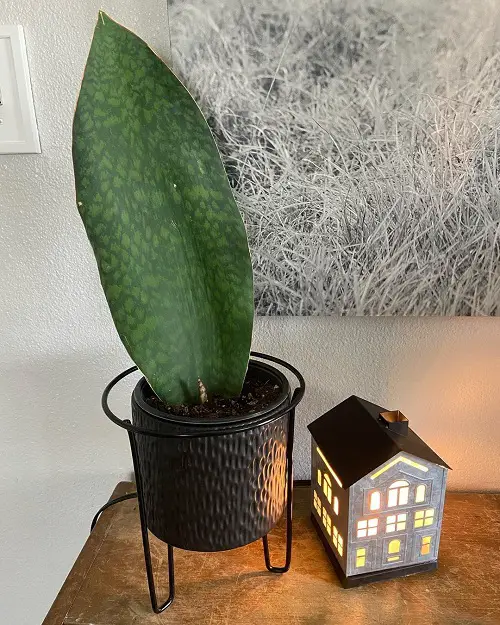Whale Fin Sansevieria Care is simple when you know the right way to do it. Let’s have a look in detail so you can grow this plant with ease!

If you want a quirky plant to add to your collection then this guide on Whale Fin Sansevieria Care will help you out!
Check out the best Types of Snake Plant Varieties to Grow Indoors here
Whale Fin Sansevieria Plant Information
Whale fin, shark fin, or Mason Congo Sansevieria (Sansevieria masoniana) is also known as Dracaena masoniana. It is a part of the Asparagaceae family and originated in the Democratic Republic of the Congo in central Africa.
This herbaceous perennial grows up to 2-3 feet tall with 1-2 feet of spread. Whale fin Sansevieria displays clusters of green-white blossoms and releases a sweet-citrus fragrance, but it rarely flowers indoors.
After blooming, Masoniana Snake Plant stops producing new foliage and continues to produce plantlets through rhizomes.
Propagating Whale Fin Sansevieria
You can have many plants by cutting out a section of both leaves and roots. Plant them in fresh soil.
- For propagating a whale fin sansevieria from a leaf, cut a healthy mature leaf from the base of the plant using a sharp scissor into 4-6 inches pieces.
- Allow the leaf pieces to sit for 2-3 days until they begin to callous.
- Dip the cut ends into rooting hormone and set the leaf-cutting into a pot filled with succulent or cactus mix.
- The root will form in 60 days and new growth will begin in the next six weeks.
- For propagating whale fin sansevieria in water, click here.
Propagating Whale Fin Sansevieria by Division / Rhizome
You can divide the plant when it starts producing pups – remove them with the help of a knife, and let them rest for 2-3 days. Then, plant them in the well-draining soil and they will root soon.
Choosing a Container

As the plant mostly grows just one leaf, it would be a good idea to choose a wider pot than a deeper one. You can start the plant in an 6-8 inches pot.
Requirements for Growing Whale Fin Sansevieria
Light
The plant grows best where it can enjoy dappled light all day long. If you want the leaves to grow bigger, make sure it gets 3-4 hours of direct morning sunlight daily.
While growing outdoors, a location with the partial sun will be best. Do remember low light can slow down growth and exposure to harsh afternoon sun can scorch the leaves.
Soil
Use sandy or loamy soil with a neutral pH. If you’re using a regular potting mix, add 50 percent perlite. Avoid adding too much vermiculite to the growing medium as it holds water.
Alternatively, you can mix equal parts of sphagnum peat moss or coco peat, perlite or coarse sand, regular potting soil, or sterilized garden soil and use the mixture as a growing medium.
Water
It is best to wait until the topsoil goes dry between watering intervals. Check the soil using your fingers and moisten the growing medium only when it feels dry to the touch.
Also, try to keep leaves dry by avoiding overhead watering.
Learn How Often to Water a Snake Plant here
Temperature
These plants grow best in temperatures between 70-90 F (21-32 C). They can easily withstand lower temperatures down to 41 F (5 C) and up to 104 F (40 C).
Whale Fin Sansevieria Care

Fertilizer
The plant is not fussy when it comes to feeding and as long as it gets good light, it will continue to grow at its own sweet pace. As it is a succulent, it would be a good idea to feed it less often than fertilize it a lot and kill it.
You can use an all-purpose liquid fertilizer like 10-10-10, once in 3 to 6 weeks when the plant is actively growing. Dilute the feed to 1/4 of its strength. Avoid fertilization during winters in a cold climate.
Re-potting
Re-potting can be done every 2-3 years by removing pups, growing them, or dividing them. The best time to do it is spring and summer.
Do remember not to use a pot larger than one size than the old one. Also, use a fresh potting mix.
Pest and Diseases
Be careful of mealybugs and spider mites. These pests suck the sap from the plant, which can make the leaves fragile and die. Use insecticidal soap to get rid of these pests.
Avoid overwatering to keep most of the potential diseases at bay.
Toxicity
As per ASPCA, Whale Fin Sansevieria may be mildly toxic to humans and pets. It has Saponins, which may result in vomiting or diarrhea if ingested.


